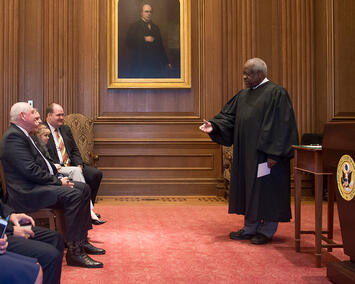
As evidence piles up indicating that President Biden’s family is at the center of a massive international bribery scheme, the mainstream media has been obsessed with documenting the alleged personal corruption of the conservative members of the Supreme Court. Justice Clarence Thomas, whom the liberal media has been denigrating since his nomination three decades ago, has come in for particular scrutiny, but he is not alone. The New York Times recently devoted a lead story to its latest exposé: the fact that the Antonin Scalia Law School at George Mason University had made itself a “friend” of the Supreme Court by lavishing “perks” on its members, such as offering guest teaching gigs in exotic locations like Iceland and Padua, Italy. As explained in a confidential memo issued by a Scalia administrator that the Times obtained, inviting Justice Neil Gorsuch to teach at the school shortly after his confirmation formed part of a strategy that aimed to make it “A Yale or Harvard of conservative legal scholarship and influence.” Other justices invited to teach included Brett Kavanaugh and Clarence Thomas.
But as the Times acknowledges (below the fold), Supreme Court justices are legally allowed to earn outside income from such sources as book royalties, investments, and teaching. In fact, the judicial code of conduct specifically encourages teaching, and “many justices have augmented” their salaries, currently under $300,000, by teaching at schools including Harvard, Duke, and Notre Dame. But the Times nonetheless expresses concern that by making use of generous donations from outside benefactors, the law school has offered “bespoke” arrangements to accommodate the justices. Meanwhile, the Times reports that the school’s “closeness to the justices has coincided with a striking upswing in its funding and academic standing,” which has helped attract “higher-caliber students.” Perhaps even more worrisome, the co-professors who joined the justices in their guest teaching assignments have sometimes filed amicus briefs on cases pending before the Court.
But it isn’t only conservative members of the Court that the law school has been able to entice. Justice Elena Kagan, a liberal, joined Justice Gorsuch on his Iceland trip and emailed a favorable judgment of the school to a George Mason professor. And Justice Sonia Sotomayor, even more consistently on the Left than Kagan, spoke on a panel at the school with Gorsuch that same year.
In sum, the Scalia Law School, far from aiming merely to indoctrinate its students in conservative thought, has sought to promote genuine judicial dialogue—much like one of its chief benefactors, the “conservative” Federalist Society headed by Leonard Leo. Indeed, all but one of the Court’s members attended the ceremony at which the school was rededicated. (So detailed is the Times’ scrutiny of the school’s endeavor to gain influence that it provides minute detail of the menu at a private luncheon Leo hosted in connection with the dedication: “vegetarian or lobster risotto,” with praise for the latter option from future Justice Kavanaugh.)
The most damning evidence the Times marshals is the possibility that the accommodations the law school provided to the justices abroad might have been more lavish than those offered on comparable trips by schools like Tulane, NYU, and Notre Dame—and that the justices’ own staffs may have helped coordinate their travel arrangements. Additional evidence that’s even less compelling includes an occasion when then-Dean Henry Butler, who sat on the board of a Montana-based property-rights organization when the Court was about to hear a case of interest to the organization, encouraged Justice Gorsuch to visit a Montana resort at its expense. Gorsuch didn’t take advantage of the invitation and was one of two dissenting votes against the side the group favored.
Read the rest of this piece at American Mind.
David Lewis Schaefer is Professor of Political Science at College of the Holy Cross.
Photo: U.S. Department of Agriculture via Flickr, in Public Domain.












